Copywriters are frequently told that it is a good idea to maintain a swipe file. Which I do.
A "swipe file" is a collection of advertising or marketing materials that have one thing in common. Either their written content or their overall presentation of a product's benefits or features is so well done that it strongly motivates the reader into completing the purchase. These are great references to review when stumped as to how best to solve a particular copywriting problem.
But I also maintain a second swipe file. And this one contains materials that are, well, incredibly bad.
On my desk, that second file is larger than the file containing the good stuff. And much of the material I consider 'bad' is there because of a single reason.
The envelope.
The 80% Rule
Advertising legend David Ogilvy once said, “On the average, five times as many people read the headline as read the body copy. When you have written your headline, you have spent eighty cents out of your dollar.”
In other words, you need to concentrate 80% of your overall efforts on crafting that perfect headline. That's the only way you're going to get your foot in the door of their hearts, their minds and, most importantly, their wallets.
The thing is, when Ogilvy was making his mark in advertising, it was a much simpler time for the American household. There were only three television networks. Most magazines on the newsstands were of general interest. And for a good many people, their window to the exciting world outside of their immediate town was through their mailboxes.
Direct mail back then often offered a cornucopia of products that they never imagined. Breathless copy enticed housewives with some helpful kitchen gadget, while Dad was convinced that the pictured lure was the secret to catching more fish. And children excitedly waited for the postman to arrive with the prize or premium they ordered for just a quarter and two cereal box tops.
But it is different now. We're more sophisticated. Being bombarded with advertising from all directions. And unfortunately, more jaded.
That Valuable Real Estate
Don't get me wrong. You can still sell by direct mail today. But it has to be done the correct way. Because unless you are a company that the recipient is either already dealing with or has specifically requested your mailer, they're going to be very suspicious of your offer. Most likely it will be tossed in the trash without a second glance.
The truth is, you have only a few seconds for them to see that one brief phrase that describes your Unique Selling Proposition.
In other words — the headline BEFORE the headline.
If Ogilvy felt that the headline was the key ingredient in order to get the prospect to read the advertising copy, what do you think happens when that ad is folded up, stuffed and basically made invisible inside an envelope?
What is written on the OUTSIDE of that envelope becomes the key as to whether the selling process takes place at all.
The copy on the envelope now becomes the overriding 80% of the sale, with the materials inside accounting for the remaining 20%.
You've Tested Your Envelopes — Right?
From what arrives in my mailbox, I find that hard to believe. In fact, it doesn't appear that any A/B split testing has taken place at all.
Someone inside the company has the assignment thrown at them to decide what to write on the envelope. And they take the easy route, basically saying "check out our stuff inside." But because they are so close to the company and its products, they can't understand how anyone would not jump at this incredible offer.
So that becomes their permanent copy on the envelope, printed alongside your name and address. And they think they are going to keep hammering you with it until they wear you down and buckle. No matter how much money is wasted on repetitive printing and postage.
Below are three examples that I feel are extremely poor work from companies that have consistently mailed me in the past year. I've flagged them because there appears to be a major disconnect between the copy that appears on their websites versus what is on the envelopes.
Again, these are just my personal opinions. And these companies will probably disagree.
You may disagree as well. Just examine the points I make to see if these companies are making the best use of their envelope's space in order to entice the prospect.
Pella Windows and Doors
Just a few minutes on their website and you can see so many selling points as to why someone might choose them to provide the doors and windows for their home:
1. They have a 94-year history of technical innovation.
2. Their ENERGY STAR certified windows can lower your energy bills, so install them before the upcoming winter.
3. All of their products are custom made for your home.
4. Pella does extensive testing of glass efficiency, wood durability and preservation, and cycle testing of individual components.
5. Their sophisticated designs will make you the envy of your neighborhood.
So what do they choose to highlight on their direct mail pieces, which I received three times in 2018?
There's a coupon inside.
Wow.
There is nothing that even conveys the cachet of the Pella name.
Quite frankly, this envelope looks like it might have been mailed from a local shop operating out of someone's garage.
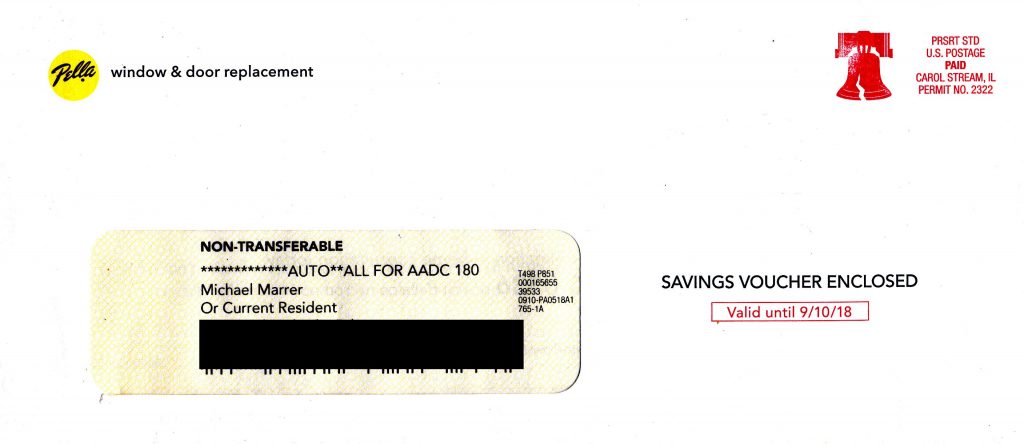
STAMPS.COM
This company provides many of the functions of the postal service, but in the convenience of your own home or office.
1. No driving to a post office, no trying to find a parking spot, and no standing in line.
2. Get postage at a discount, something you can't get at a post office counter.
3. You can print domestic and international postage right at your desk.
4. None of the extra costs and fees that come with other companies' postage meters.
I received four of these mailers in 2018. Their selling point? There was supposedly around $4.50 worth of postage inside.
Actually, it was sort of a bait and switch. Yes, there were nine stamps inside. Blank stamps. With no postage.
To get your free "working" stamps you actually had to commit to their service at $15.99 per month and download some software. Only then you could print out your free postage.
But if simply getting nine stamps was all that it took to trip your trigger (and that seems to me an awfully low trigger point), then they did manage to get you to open the envelope to read the offer.
I just think that there are more compelling points they could have used to sell their service.
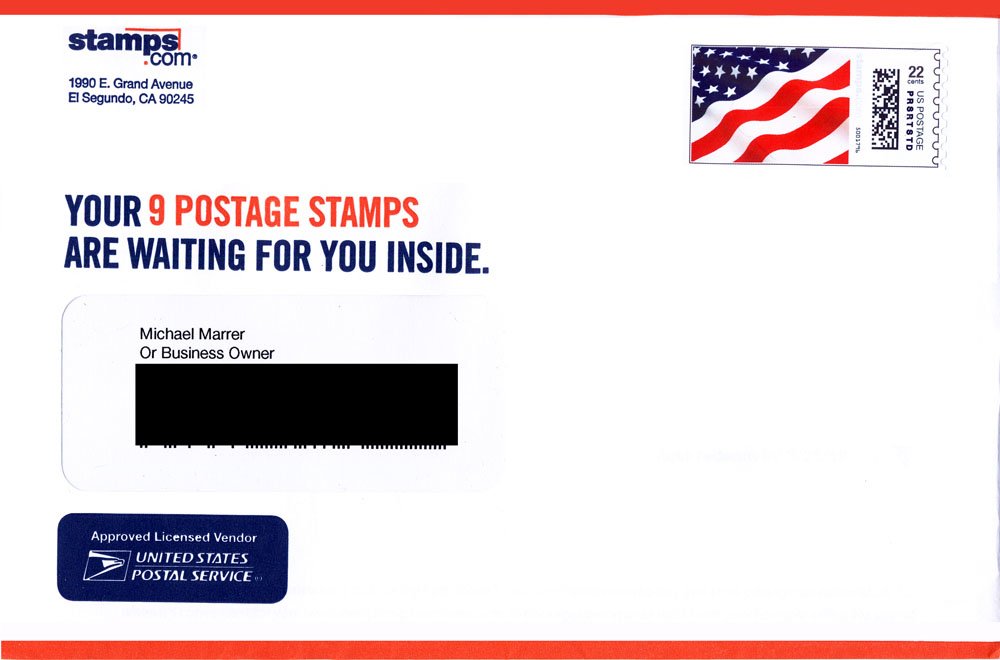
Spectrum (formerly Time Warner Cable)
This one is different than the other two examples. These mailings are going to existing customers. But instead of promoting some benefit that would make the customer excited to partake in the upgrade, they instead use deception to try to imply that there may be a problem with their account.
Time Warner has, for years, seemed to be a one-trick pony.
Their advertising, which I got incessantly as a customer, was this:
1. We offer television
2. We offer internet
3. We offer telephone
Subscribe to all three and it'll cost you less money
You may have remembered them from an article I wrote in 2017, although back then I did not specifically identify them by name
(See Hounding Customers With the Same Offer Is Not "Marketing").
Up until then, they were trying to get customers to bundle all three services into one package. With the rebranding as Spectrum, they changed the upsell into a bundle containing just two of the services. They're also offering a smaller television package, as well as a way to stream channels from the Internet.
But no matter what particular package they're selling, the envelopes — which arrive like clockwork about every three weeks — all look basically the same.
Instead of promoting a unique selling proposition, they use bold words like "IMPORTANT INFORMATION ENCLOSED", "NOTICE" and — my favorite — "CARD INSIDE. DO NOT BEND".
With that latter one, from the feel of the envelope, you initially think that it is some sort of credit or debit card. Nope. It's a 3.5" x 6" piece of heavy card stock that reminds you of the name of the offer, the monthly cost and the phone number to call.
Not exactly how to win friends and influence people.
I'll ask the same question that I asked two years ago. How much lower would customers' bills be if so much money wasn't wasted trying to force them to upgrade to something they do not want by sending the exact same offer over and over and over . . . ?
Actually, this won't be a problem for me anymore. Writing this article prompted me to call them to take me off their mailing list, other than to send me my monthly bill.
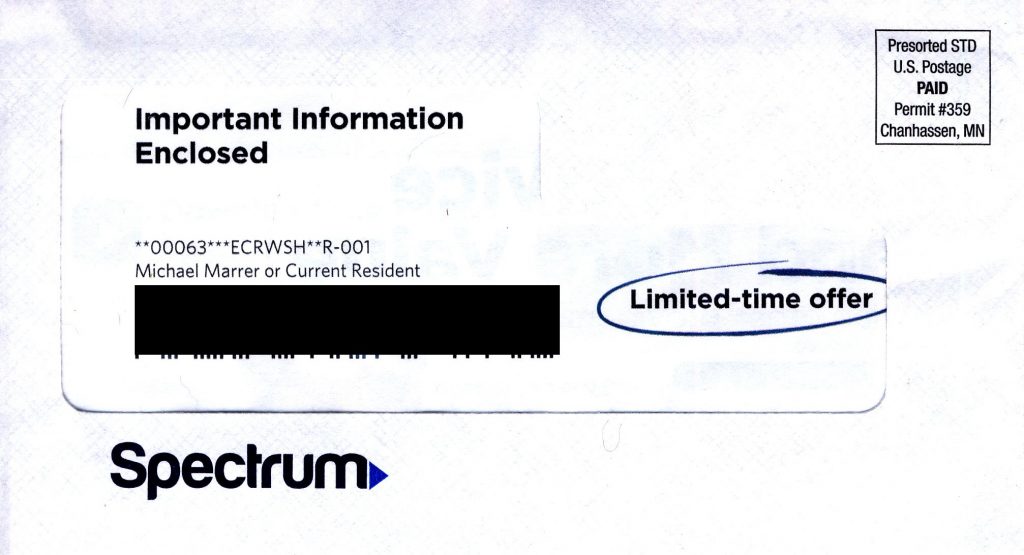
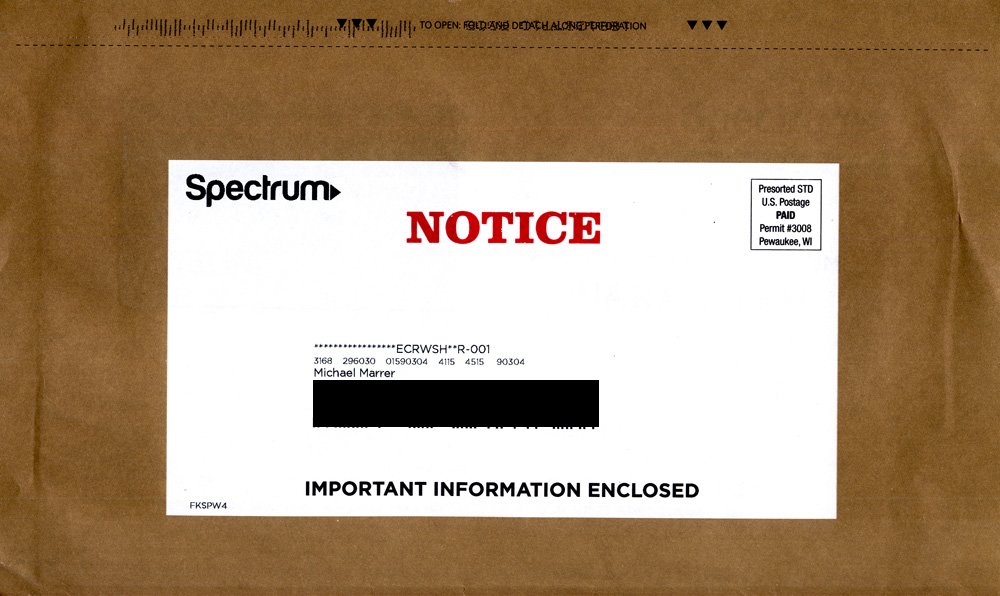
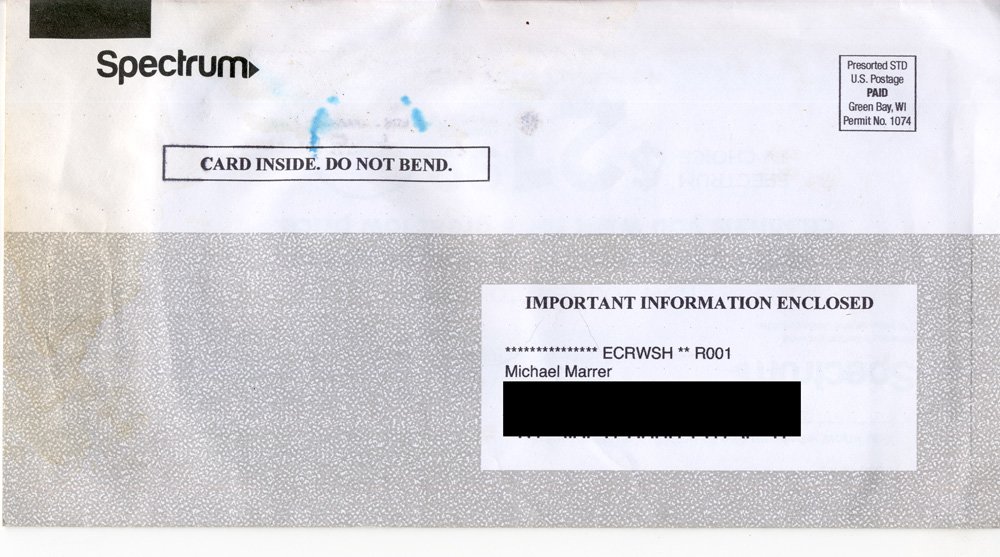
In Conclusion
So, do you think this is the best these companies can do? Is this what they consider their "control" copy?
If so, I welcome the chance to have my suggestions be tested against their "control". With, of course, the standard agreement usually found in the direct-response industry that I receive a percentage of the increased sales that outperformed the control. And thus become the new control.
Any takers?
© 2019 Michael Marrer, Silver Lake Wordsmiths & Marrer Enterprises, Inc.

